Capsella bursa-pastoris (shepherd's purse)
Identity
- Preferred Scientific Name
- Capsella bursa-pastoris (L.) Medik. (1792)
- Preferred Common Name
- shepherd's purse
- Other Scientific Names
- Thlaspi bursa-pastoris L.
- International Common Names
- Spanishbolsa de pastor
- Frenchbourse-à-pasteurcapselle bourse à pasteur
- Portuguesebolsa-do-pastor
- Local Common Names
- Denmarkalmindelig hyrdetaske
- Egyptkees el-raat
- Finlandlutukka
- GermanyHirtentäschelkraut
- Italyborsa pastore
- Japannazuna
- Netherlandsherderstasje
- Swedenlomme
- EPPO code
- CAPBP (Capsella bursa-pastoris)
Pictures
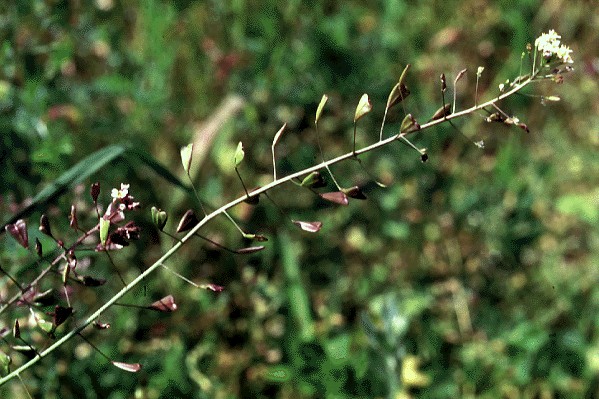
Pods and flowers
Flowers white in long terminal racemes with pinkish or green calyx and white corolla. Pod flattened, triangular, notched at the apex and stalked.
Dirk Aderhold
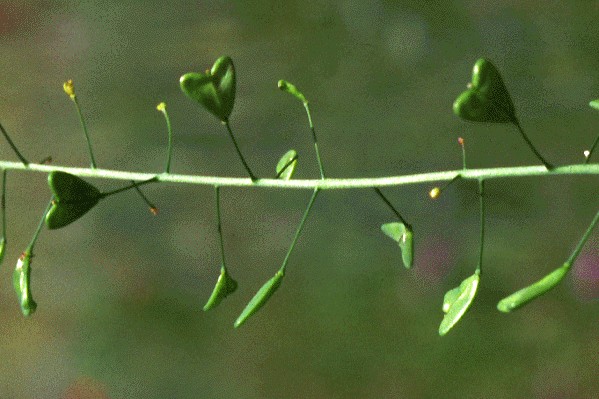
Pods
Pod (silique) flattened, triangular, notched at the apex and stalked. Each pod contains about 20 seeds attached to a thin membraneous septa.
Dirk Aderhold
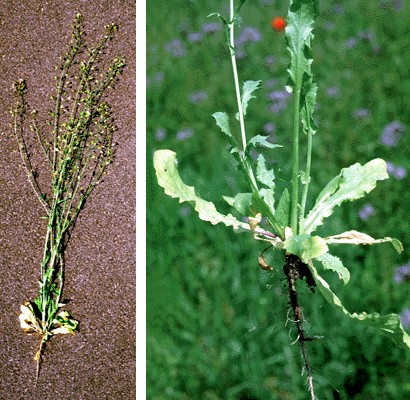
Whole plant
Stems erect, solitary or branched from the base; root a thin taproot, sometimes branched. Basal leaves petioled, oblanceolate with blunt tip, commonly deeply lobed, 15 x 4 cm, spread in rosette form; upper stem leaves smaller, 8 x 1.5 cm, alternate, sessile, clasping the stem with ear-like projections.The flowers are white in long terminal racemes with a pinkish or green calyx, a white corolla and four obovate petals of 2 mm length. The pod (silique) is flattened, triangular, notched at the apex and stalked. Each pod contains about 20 seeds attached to a thin membraneous septa. The seed is about 1 mm long, oblong, orange-yellow with a dull and punctured surface.
Dirk Aderhold
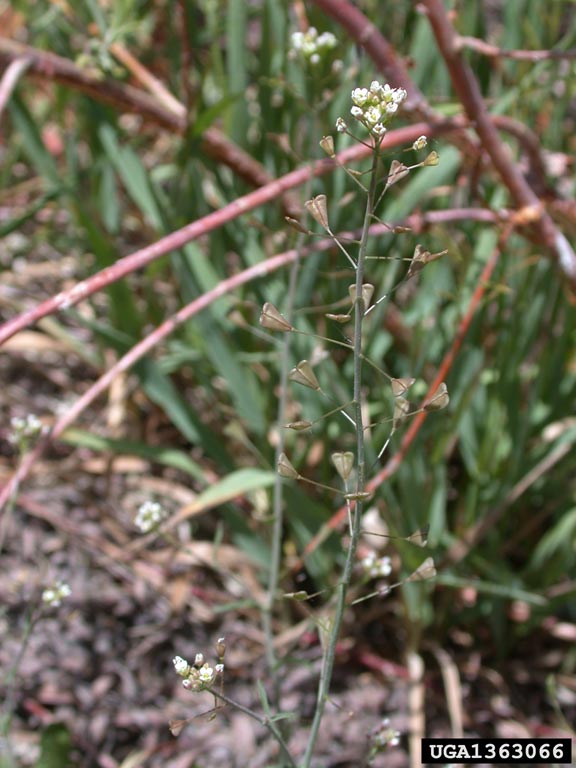
Capsella bursa-pastoris
Mary Ellen (Mel) Harte, bugwood.org
Refer to Bugwood: http://www.bugwood.org/ImageUsage.html
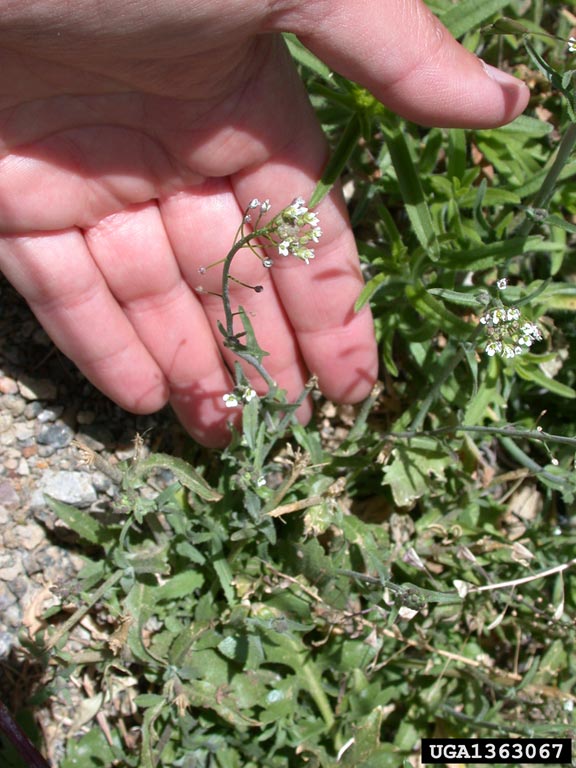
Capsella bursa-pastoris
Mary Ellen (Mel) Harte, bugwood.org
Refer to Bugwood: http://www.bugwood.org/ImageUsage.html
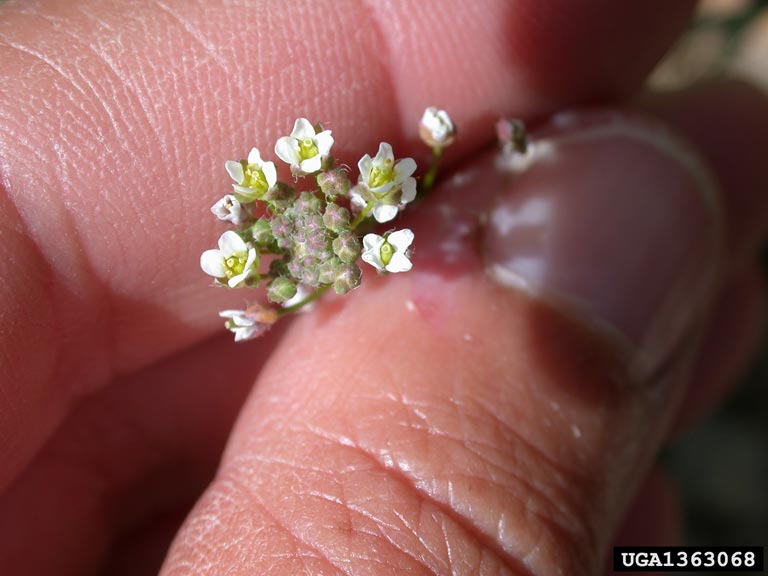
Capsella bursa-pastoris
Mary Ellen (Mel) Harte, bugwood.org
Refer to Bugwood: http://www.bugwood.org/ImageUsage.html
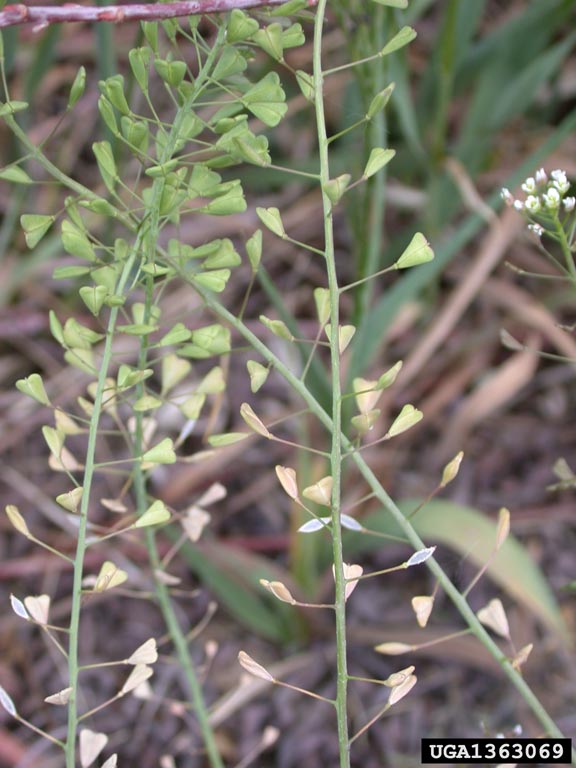
Capsella bursa-pastoris
Mary Ellen (Mel) Harte, bugwood.org
Refer to Bugwood: http://www.bugwood.org/ImageUsage.html
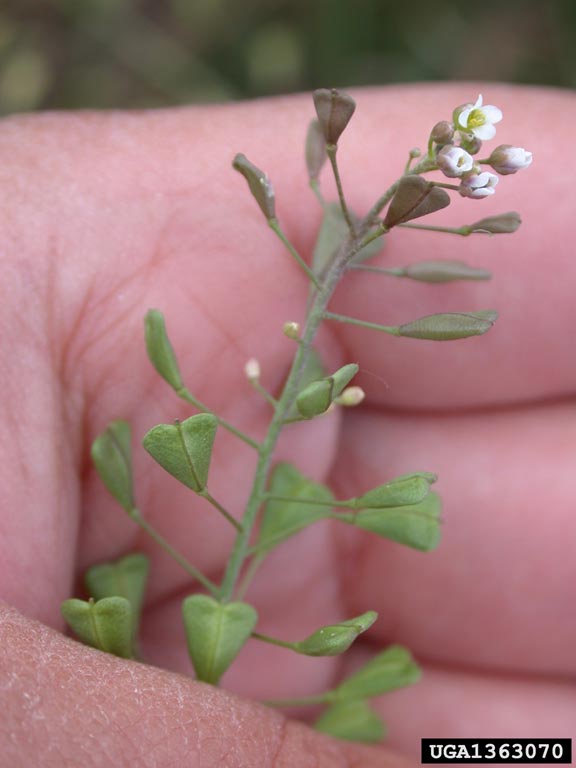
Capsella bursa-pastoris
Mary Ellen (Mel) Harte, bugwood.org
Refer to Bugwood: http://www.bugwood.org/ImageUsage.html
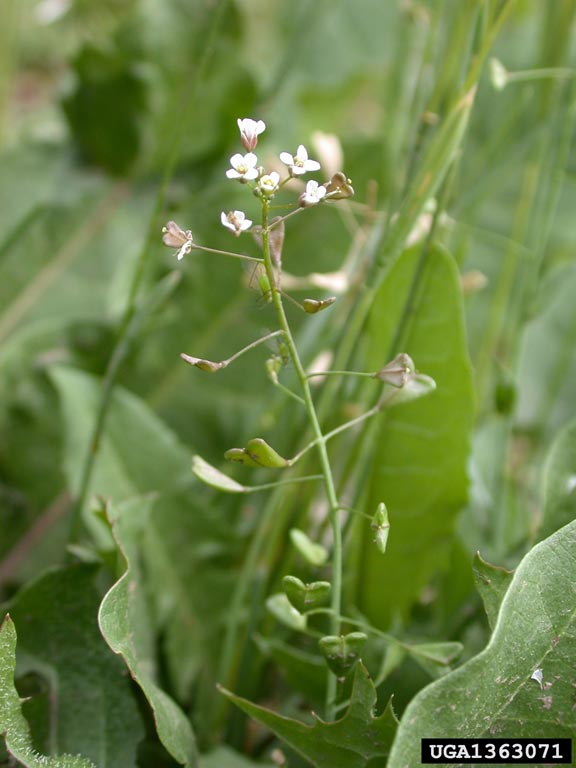
Capsella bursa-pastoris
Mary Ellen (Mel) Harte, bugwood.org
Refer to Bugwood: http://www.bugwood.org/ImageUsage.html
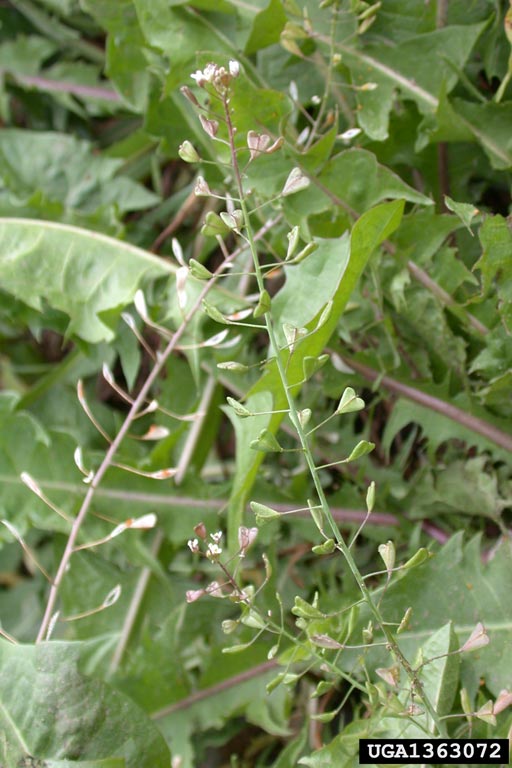
Capsella bursa-pastoris
Mary Ellen (Mel) Harte, bugwood.org
Refer to Bugwood: http://www.bugwood.org/ImageUsage.html
Distribution
Host Plants and Other Plants Affected
| Host | Host status | References |
|---|---|---|
| Allium cepa (onion) | Main | Hwang et al. (2015) Tahira and Khan (2017) |
| Avena sativa (oats) | Main | |
| Beta vulgaris var. saccharifera (sugarbeet) | Main | |
| Brassica napus | Unknown | Aghajani and Safaei (2008) |
| Brassica napus var. oleifera | Unknown | Goerke et al. (2007) |
| Citrus | Main | |
| Cucumis (melons, cucuimbers, gerkins) | Unknown | Vafaei and Mahmoodi (2017) |
| Hordeum vulgare (barley) | Main | Pala (2020) |
| Linum usitatissimum (flax) | Main | |
| Lupinus luteus (yellow lupin) | Unknown | Piekarczyk et al. (2019) |
| Medicago sativa (lucerne) | Main | Hassannejad and Ghafarbi (2014) |
| Nicotiana tabacum (tobacco) | Main | |
| Pisum sativum (pea) | Main | Piekarczyk et al. (2019) |
| Secale cereale (rye) | Main | |
| Solanum lycopersicum (tomato) | Unknown | Macharia et al. (2016) Stobbs et al. (2009) |
| Solanum tuberosum (potato) | Main | |
| Triticum (wheat) | Main | |
| Triticum aestivum (wheat) | Main | Shah et al. (2014) Fazal and Muhammad (2015) Kämpf et al. (2016) Shah and Khan (2006) |
| Triticum turgidum subsp. durum | Unknown | Woźniak (2020) |
Prevention and Control
Cultural Control
The addition of Brassica hirta to air-dried soil (20g/400 g soil) reduced the emergence of C. bursa-pastoris by 97% (Al Khatib et al., 1997).
C. bursa-pastoris in apple orchards was suppressed by the dominance of water foxtail (Alopecurus aequalis var. amurensis) in the Korea Republic (Jung et al., 1998).
The effects of grazing intensity on weed populations in annual and perennial pasture systems has been studied by Harker et al., (2000) in the USA. In perennial pastures, each unit increase in grazing intensity led to 51 more C. bursa-pastoris per m². At lower levels of grazing intensity, C. bursa-pastoris and other species were most abundant in the annual pastures. The response of the weed population to grazing pressure in annual pasture systems is restricted because of annual tillage and MCPA. Therefore, pasture managers may subject annual pastures to heavy grazing pressure with less negative weed population consequences than perennial pastures where herbicides are not applied.
Tillage for seedbed preparation in the annual system supports a proliferation of annual weeds in the spring.
Manual and Mechanical Control
C. bursa-pastoris can be readily controlled by conventional manual and mechanical weeding. The influence of four tillage systems, varying from intensive to zero tillage, on weed populations and the vertical distribution of weed seeds in the soil was determined by O´Donovan and Mc Andrew in Canada (2000). The winter annuals such as shepherd's-purse (C. bursa-pastoris) increased in the soil seedbank as tillage was reduced, however, higher populations in the soil seedbank did not always result in higher spring seedling populations under zero tillage.
The addition of Brassica hirta to air-dried soil (20g/400 g soil) reduced the emergence of C. bursa-pastoris by 97% (Al Khatib et al., 1997).
C. bursa-pastoris in apple orchards was suppressed by the dominance of water foxtail (Alopecurus aequalis var. amurensis) in the Korea Republic (Jung et al., 1998).
The effects of grazing intensity on weed populations in annual and perennial pasture systems has been studied by Harker et al., (2000) in the USA. In perennial pastures, each unit increase in grazing intensity led to 51 more C. bursa-pastoris per m². At lower levels of grazing intensity, C. bursa-pastoris and other species were most abundant in the annual pastures. The response of the weed population to grazing pressure in annual pasture systems is restricted because of annual tillage and MCPA. Therefore, pasture managers may subject annual pastures to heavy grazing pressure with less negative weed population consequences than perennial pastures where herbicides are not applied.
Tillage for seedbed preparation in the annual system supports a proliferation of annual weeds in the spring.
Manual and Mechanical Control
C. bursa-pastoris can be readily controlled by conventional manual and mechanical weeding. The influence of four tillage systems, varying from intensive to zero tillage, on weed populations and the vertical distribution of weed seeds in the soil was determined by O´Donovan and Mc Andrew in Canada (2000). The winter annuals such as shepherd's-purse (C. bursa-pastoris) increased in the soil seedbank as tillage was reduced, however, higher populations in the soil seedbank did not always result in higher spring seedling populations under zero tillage.
Chemical Control
Due to the variable regulations around (de-)registration of pesticides, we are for the moment not including any specific chemical control recommendations. For further information, we recommend you visit the following resources:
•
EU pesticides database (http://ec.europa.eu/food/plant/pesticides/eu-pesticides-database/)
•
PAN pesticide database (www.pesticideinfo.org)
•
Your national pesticide guide
Impact
C. bursa-pastoris generally does not give any serious problems on arable land under short rotations. Although readily controlled by cultivation, C. bursa-pastoris produces large quantities of seed and therefore dense infestations can form a serious weed problem in some cases (Ivens, 1971).Studies carried out in a wheat field in China by Yu-JinFeng et al., (2002) determined that the eco-economic threshold period (ETP) was of 180-200 plants/m2 of broad-leaved weeds such as C. bursa-pastoris, Descurainia sophia and Silene conoidea.Suspected nitrite poisoning in pigs caused by Capsella bursa-pastoris has been suggested by Wiese and Joubert (2001).C. bursa-pastoris may be important as an alternative host of many plant pathogens causing crop damage. See Natural Enemies for further details.
Information & Authors
Information
Published In
Copyright
Copyright © CABI. CABI is a registered EU trademark. This article is published under a Attribution-NonCommercial-NoDerivatives 4.0 International (CC BY-NC-ND 4.0)
History
Published online: 19 September 2022
Language
English
Authors
Metrics & Citations
Metrics
SCITE_
Citations
Export citation
Select the format you want to export the citations of this publication.
EXPORT CITATIONSExport Citation
View Options
View options
Get Access
Login Options
Check if you access through your login credentials or your institution to get full access on this article.


